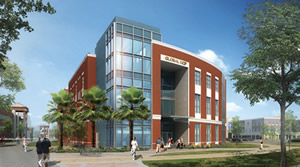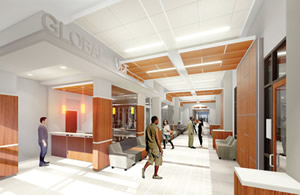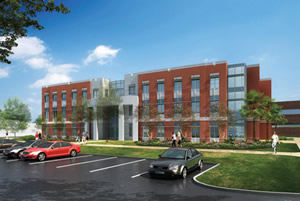Globalization: Serving a Growing Market

RENDERINGS COURTESY OF SHENKELSHULTZ
The overall number of international students in the United States has grown 72 percent in 15 years, from 514,723 in 1999/2000 to 886,052 in 2013/14, according to “Open Doors 2014: A 15-Year Snapshot,” which is published annually by the Institute of International Education in partnership with the U.S. Department of State’s Bureau of Educational and Cultural Affairs, and which reports the findings of annual statistical surveys of U.S. campuses regarding international student and scholar mobility (www.iie.org/Research-and-Publications/Open-Doors/Data). The document also indicates that, “All the leading U.S. host institutions have more than doubled their international student enrollment through the past 15 years, while each institution’s share of total U.S. international student enrollment has remained about one percent per institution. In 2000, 135 institutions hosted 1,000 or more international students and, in 2014, there are 231 institutions that host 1,000 or more international students.”
Numbers in Action
From these statistics, it is clear that the globalization of higher education is increasing. The University of Central Florida (UCF) In Orlando is a real-life example. “We have two types of students, non-degree-and degree-seeking, at both the undergraduate and graduate level,” says Cynthia Y. Young, Ph.D., UCF’s interim vice provost for International Affairs and Global Strategies (IAGS). IAGS is a new division “committed to enhancing international opportunities, services and experiences for students, scholars, institutional partners and the UCF community,” according to the university’s website.
“In general, we have 500 to 600 international undergraduate students, 900 to 1,000 international graduate students and 300-plus English Language Institute (ELI) non-degree seeking students,” says Young. UCF’s ELI prepares non-native English speakers to enter U.S. colleges and universities. The program is designed so that students take three semesters of intensive English at beginning, intermediate, high intermediate and advanced levels. Since 1987, students from more than 70 countries have studied through ELI.

RENDERINGS COURTESY OF SHENKELSHULTZ
ARRIVE AND THRIVE. Ensuring that international students enjoy and value their time on American campuses as well as succeed academically is important to continuing recruitment. Putting plans in place to assist international students with adjusting to campus life in the U.S. can include designing facilities tailored to programs and services for these global scholars. One such project is underway on the campus of the University of Central Florida. Once it is completed, the building will be UCF’s centerpiece for supporting the university’s international students.
“We also have a partnership with the Global Achievement Academy,” Young says, “recruiting international undergraduate students through a transition program to get them ready for higher education; that’s about 150 students per year.” Specifically, the Global Achievement Academy is a program that combines credit-bearing modules in three subject-specific tracks, English Language instruction and American cultural experiences to prepare students for year two of one of UCF’s 90+ degree programs.
“We are looking to increase all of those numbers,” continues Young. “We hope to be at about 2,500 international graduate, 1,500 international undergraduate and 300 to 400 ESL students per year. Our mission is to internationalize UCF and strengthen our global footprint. To do that, we need a diverse student population.” By diverse, she means international representation from many countries. And, in fact, according to the university’s website, it currently has a total of 157 countries represented among its 63,000 students, and the top five countries from which international students hail are China, India, Venezuela, Colombia and Brazil.
Why is it important to UCF administrators to strengthen the university’s global footprint? “We desire to prepare our students to have a global cultural competency,” answers Young, “as we know they will work in a global world. From a practical standpoint, we’re laying the groundwork for students who will have careers with global companies.”
Space for All
In light of the increase of international students across the country, some administrators are seeing a need for facilities designed to serve the unique needs of international scholars. One such facility is under construction on the UCF campus. When completed in January 2016, the LEED-Silver-targeted Global UCF building will serve two purposes. “First, it strengthens our international presence on campus in that it’s located on Memory Mall in the heart of campus,” explains Young. “Second, it strengthens synergies between the groups that assist international students in that, rather than being strewn across campus in different buildings, they will be centrally located under one roof.”
To illustrate the current challenge of having segregated services, from north to south the UCF campus is about a half-hour walk. “We have services at both ends and also in the middle,” says Mikel Etxeberria, UCF Information Technology manager. Adds Nataly Chandia Viano, UCF assistant vice president of International Affairs and Global Strategies: “Our students can’t tell from looking at a map just how huge UCF is and, when they first arrive from another country, it’s challenging to find the first person they need to contact.”
Needless to say, both administrators and international students are excitedly awaiting the completion of the $11.2-million building, designed by Orlandobased SchenkelShultz Architecture. Administrators wanted a facility that reflects an accepting and welcoming feeling, and that begins with lots of natural daylight. “It was also intentional to design the building so that students get the help they need immediately,” says Young. “Therefore, the most outward-facing staff, such as immigration, are found on the first floor.”

RENDERINGS COURTESY OF SHENKELSHULTZ
A second first-floor design element is a glass-walled Global Suite, designed for advising. “It is a place where students can meet with their advisors or among themselves,” says Patrick G. Rauch, AIA, an associate with SchenkelShultz. “It helps create a strong sense of welcome and presence.”
A third first-floor design element is a 45-seat cluster classroom equipped with flexible furniture to foster collaboration, group activities and traditional lectures. “It isn’t simply rows of seats with tablet armchairs,” explains Daniel M. Tarczynski, AIA, a partner with SchenkelShultz. “There’s a row of seats. Behind that is an elliptical table. Behind that is another row of seats. Students in the first row can turn around so that there are two rows of students at a table who automatically become a team, and they can communicate and collaborate. That pattern repeats to the back of the classroom.”
Yet another first-floor design element, also intentionally created to promote collaboration outside the classroom, is an active student concourse offering six separate areas for informal meetings and study. “The concourse is so much more than a hallway,” says Rauch, “and that user-friendly feature makes for a feeling of acceptance. In fact, each of the three floors features a concourse.”
A final first-floor design element is a conference center. “This space will be used during the day for classroom space and also after hours for social use,” says Tarczynski, “so we designed it to be flexible to accommodate whatever activity is occurring in it. Specifically, it features partitions to create different numbers of rooms.” Following through with the idea that the building is designed to get students the help they need as quickly and easily as possible, faculty and ELI are on the second floor, and administrative offices and a meditation room with a foot wash for religious exercise are on the third floor. In all, there are more than 40 offices, three multipurpose rooms and 18 25-seat classrooms.
With this new facility, UCF administrators are well on their way of meeting their goal to increase their international student population, as well as thoughtfully meet their needs. The building is an idea whose time has come as campuses across the country are also welcoming more and more international students.
This article originally appeared in the issue of .